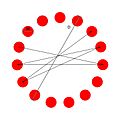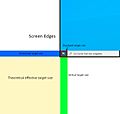Fitts's law facts for kids
Fitts's law is a cool idea in science that helps us understand how quickly people can move their hands or fingers to hit a target. It says that the time it takes to reach a target depends on two main things: how far away the target is and how big it is. The farther away a target is, or the smaller it is, the longer it will take you to hit it accurately.
This rule was first described by a smart guy named Paul Fitts in 1954. Today, Fitts's law is super important for designing things like computer screens, phone apps, and even physical buttons. It helps make sure that these tools are easy and quick for people to use.
Contents
What is Fitts's Law?
Fitts's law is a mathematical rule that predicts how long it takes to move to a target. Imagine you're trying to tap a button on a screen. Fitts's law tells us that if the button is small and far away, it will take you longer to tap it than if it's large and close by.
This law is used in many areas, especially in human–computer interaction. This field studies how people use computers and other technology. By understanding Fitts's law, designers can create better, more user-friendly products.
How Does It Work?
The law basically says that the difficulty of hitting a target increases with distance and decreases with size. Think of it like this:
- Distance: If you have to move your hand a long way, it takes more time.
- Size: If the target is very small, you have to be more careful and precise, which also takes more time.
So, to make something easy to hit, designers try to make it as close and as large as possible. This helps people use devices faster and with fewer mistakes.
Everyday Examples
You might not realize it, but Fitts's law is at work all around you!
- Computer Mouse: When you move your mouse cursor to click an icon, it's easier to click a big icon that's close to where your cursor already is.
- Smartphone Keyboards: The keys on your phone's keyboard are designed to be big enough to tap easily, even though the screen is small.
- ATM Buttons: Buttons on an ATM are usually large and spaced out. This makes them easy to press without hitting the wrong one.
- Car Controls: Important controls in a car, like the volume knob or turn signal, are often placed where they are easy to reach and operate quickly.
Why Is It Important for Computers?
Fitts's law is a key principle in user interface (UI) design. A user interface is what you see and interact with on a screen or a device. Good UI design makes technology simple and enjoyable to use.
If a designer ignores Fitts's law, a computer program or device might be frustrating to use. Imagine trying to click tiny buttons that are far apart on a screen. It would take a lot of effort and time!
Designing User Interfaces
Designers use Fitts's law to make sure that important buttons and controls are easy to click. Here are some ways they do it:
- Larger Buttons: Frequently used buttons, like "OK" or "Submit," are often made larger.
- Closer Targets: Menus often pop up right next to your mouse cursor, so you don't have to move it far.
- "Magic Corners": In some computer systems, if you move your mouse all the way to a corner of the screen, it automatically hits a target like the "Start" button. This is because the corner acts like an infinitely large target, making it very easy to hit.
- Radial Menus: These are menus that appear in a circle around your cursor. Each option is the same distance from the center, and they are often large, making them quick to select.
Who Was Paul Fitts?
Paul Fitts was an American psychologist. He was born in 1912 and passed away in 1965. He was very interested in how people perform tasks, especially in areas like aviation and human-machine systems.
In 1954, he published his famous paper that introduced Fitts's law. His work helped create the field of ergonomics, which is about designing equipment and workplaces to fit the people who use them. His ideas are still very important today for making technology easier and more efficient for everyone.
Images for kids
-
Magic Corners in Microsoft Windows
See also
 In Spanish: Ley de Fitts para niños
In Spanish: Ley de Fitts para niños





